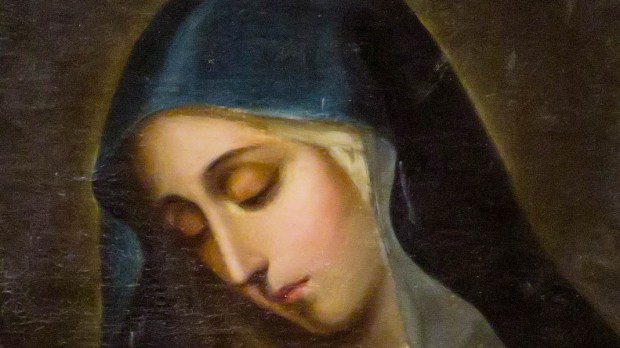I want to spend Holy Week with Mary this year. Not only was she there, watching it all, but her Immaculate Conception means that she — alone among everyone in history — had a pure understanding of the passion, death, and resurrection of her son.
On Holy Thursday, when Jesus gave us his body, Mary knew just what that meant.
Since Mary lived with St. John the Evangelist, you can hear Mary over John’s shoulder — or, better, on his mind — in the words of John’s Gospel. John doesn’t describe the Last Supper but his sixth chapter comments on it. Catholic University’s Michael Pakaluk makes both those points in his excellent bookMary’s Voice In the Gospel According to John.
So, on Holy Thursday we hear, “This is my body that is for you. Do this in remembrance of me.” And St. John tells us what that meant: “I am the living bread that came down from heaven; whoever eats this bread will live forever; and the bread that I will give is my flesh for the life of the world.”
In this, “We hear the oversound of Mary’s voice,” writes Pakaluk, “preferring to present the Eucharist as akin to the Incarnation” when the Word became flesh and dwelt among us.
He also adds that the oddness of expecting someone’s flesh to nourish another is not odd to a mother who carried a child in the womb and then nursed him at her breast. As St. John Henry Newman put it, “He took his flesh and his blood … from the flesh, from the veins of Mary.”
On Holy Thursday I want to receive him the way he received her.
On Good Friday at noon, Mary was transformed — and she knew it.
The death of Jesus on the cross must have been a more powerful experience for Mary than for anyone else.
As Pope Pius IX proclaimed in 1854: “The most Blessed Virgin Mary was, from the first moment of her conception, by a singular grace and privilege of almighty God and by virtue of the merits of Jesus Christ, Savior of the human race, preserved immune from all stain of original sin.”
That means where we see the cause of our future salvation on Good Friday, she sees the reason for her original grace. More than that — where we see the cause of our obedience; she sees the fruit of her obedience. As St. Irenaeus says, “Being obedient she became the cause of salvation for herself and for the whole human race.”
It’s a strange interplay between her Yes and her son’s. “The everyday obedience of Jesus to Joseph and Mary both announced and anticipated the obedience of” the Agony in the Garden, says the Catechism. And his public ministry, which began in obedience to his Mother at Cana, ends in obedience to his Father at Calvary.
As I venerate the cross, I want to join my Yes to hers, and to his.
On Good Friday at 3, when he was laid in her lap, Mary held him — again.
Jesus spent his life restlessly serving his people, and said, “Foxes have holes, and birds of the air have nests; but the Son of Man has nowhere to lay his head.”
He did lay his head in one place, though — the lap of his mother. As she held him at the foot of the cross, she must have remembered when she held him as an infant, grateful that he could sleep at last.
On Good Friday, at the Pietà — or at the Madonna and Child — I’ll ask to rest there also, since he himself said “Behold your Mother!”
Finally, on Holy Saturday, when the apostles were giving up on Jesus, Mary was conquering with him.
The Apostles’ Creed tells us what happened on Holy Saturday: “He descended into hell.” An ancient Christian homily imagines what that was like: “He goes to free the prisoner Adam and his fellow-prisoner Eve from their pains, he who is God, and Adam’s son,” it says.
The New Adam went to rescue the Old Adam; and that means the Old Eve was freed by the New Eve — “Death through Eve, life through Mary,” as St. Jerome put it.
We forget that Mary is not simply the downcast Lady of pious statues — she is also “fair as the moon, bright as the sun, and terrible as an army with banners.” She is a fierce queen, fierce as any mother whose children are being threatened.
So I want to wait with Mary on Holy Saturday for her victory to come on Easter morning.

